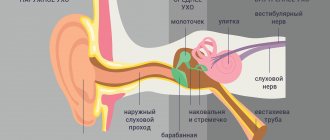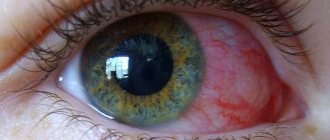One of the common causes of blocked ears is associated with the formation of wax plugs. In this case, you need to rinse the ear canals with powerful pressure of a 0.9% salt solution or clean water. If congestion is accompanied by other symptoms (pain, discharge), you will need to consult a doctor.
Causes of stuffy ears
Hearing impairment does not always appear due to the development of pathology in the auricle. The main mechanisms of action leading to initiation are:
- formation of sulfur plug. The natural protection of the ear is wax, a secretion produced by tissues to protect the passages from dust and dirt. Sometimes the plug becomes very compact, and if it is not removed in time, hearing is impaired and discomfort occurs;
- false feeling of congestion due to age-related changes, development of hearing loss;
- a foreign body enters;
- Inflammation (tubo-otitis) develops in the Eustachian tubes. The causes of eustachitis are advanced runny nose or improper treatment, violation of the procedure for rinsing the nasal sinuses;
- congestion due to allergies;
- narrowing (spasm) of blood vessels is caused by high blood pressure, which, in turn, causes ear congestion;
- otitis – acute inflammation of the middle ear, accompanied by pain;
- various viral and infectious diseases of the ears.
Useful to read: What to do if your child’s ear hurts.
What to do if your ears are blocked
Surely everyone has had their ears blocked at least once in their life.
The situations that lead to this are quite diverse; they can be either completely physiological or signal problems in the functioning of our hearing organ.
In what cases should you be wary and listen more closely to your body, and when should you not worry? How to get rid of unpleasant feelings?
“Safe” causes of ear congestion
Pressure drop.
This usually happens when taking off and landing an airplane, riding an elevator, and traveling at high speeds. In this case, congestion in the ears is not a pathology.
Read also: Tinnitus
The appearance of the symptom is due to the fact that due to a sharp drop in pressure between the middle ear cavity and the environment does not have time to equalize, which leads to a decrease in the mobility of the eardrum and unpleasant sensations.
What to do?
In order to quickly get rid of the feeling of congestion, you can use a few simple techniques. During a pressure drop (or before):
- drink water in small sips;
- sucking a candy cane or chewing gum;
- to yawn.
All these techniques are aimed at opening the Eustachian tube, which connects the middle ear and nasopharynx (the pressure in the nasopharynx is the same as in the environment). When the pipe opens, the pressure between the cavities is equalized, and the unpleasant feeling disappears.
Water getting into the ear.
In this case, water is a kind of obstacle to the sound, which causes congestion.
What to do?
In order to quickly remove water from the ear, you need to pull the auricle up and back and tilt your head towards the affected ear. If this does not help, you can drop a few drops of an alcohol solution into your ear to help the water dry out faster.
Both of these causes, as a rule, do not pose a threat to the body, are not accompanied by other symptoms and can be easily dealt with on your own.
“Dangerous” ear congestion
But there are more serious reasons for the appearance of the symptom. As a rule, these are diseases of the hearing organs, which, in addition to congestion, are accompanied by a number of other symptoms and require consultation with a doctor. These include the following conditions.
Sulfur plug.
Congestion, as with simple exposure to water, appears after bathing and is associated with a mechanical obstruction in the path of sound, but differs from the “water obstruction” by a longer feeling of congestion that does not go away on its own, a sharp decrease in hearing, a feeling of itching and pressure in the ear.
What will the doctor do?
The doctor will remove the wax plug by rinsing the outer ear canal.
Otitis and eustachitis.
Inflammatory diseases of the ear and eustachian tube can also cause ear congestion.
Due to inflammatory swelling of the mucous membrane of the middle ear and the Eustachian tube, the function of the latter is disrupted, which leads to a disruption in the pressure equalization between the middle ear and the nasopharynx and the appearance of congestion. In addition to this symptom, pain in the ear area, decreased hearing, sometimes discharge of pus from the external auditory canal, as well as general reactions of the body to inflammation - increased body temperature, general weakness, fatigue. What will the doctor do?
The doctor will prescribe a course of antibacterial drugs according to the clinical picture of the disease.
Inflammatory diseases of the nasopharynx.
The mechanism of ear congestion here is approximately the same as in the previous group of diseases.
The inflammatory process in the nasopharynx is usually accompanied by involvement of the Eustachian tube with all the ensuing consequences. As a rule, this group of diseases is accompanied by pain in the throat, nasal congestion, runny nose, and increased body temperature. What will the doctor do?
The doctor will prescribe a course of antibiotics or antiviral drugs depending on the specifics of the disease.
Diseases of the inner ear.
These include Meniere's disease, damage to the auditory nerve, acoustic trauma, etc. The appearance of congestion is associated in this case with a disruption in the functioning of the auditory nerve and distortion of sound perception.
The diseases are accompanied by dizziness, hearing loss, and sometimes nausea and vomiting. What will the doctor do?
The doctor will conduct a series of special tests to determine the level of damage to the auditory nerve and, based on the data obtained, prescribe the necessary treatment.
The article lists the most common causes of ear congestion, but this symptom can accompany a variety of unexpected diseases. Therefore, if ear congestion appears regularly, you should consult a doctor for examination and to identify the causes of this condition.
Be healthy!
Olga Starodubtseva
Photo depositphotos.com
Related products: (salicylic alcohol), (boric acid)
Clogged ears: a sign of illness or congestion
Often, hearing impairment or loss can be due to a cold with complications in the form of the development of inflammatory processes. Clogged ears are a symptom, not a disease, but in any case it is recommended to get examined.
A visit to the doctor is necessary if:
- the cold has passed, but the symptom of congestion remains;
- hearing impairment persists for several days and pain develops;
- discharge appears from the auricle, often purulent;
- dizziness appears.
General weakness, decreased tone, and increased temperature during inflammatory processes may develop.
The presence of these signs poses a certain health risk, so you should visit a doctor and undergo examinations.
Independent treatment measures are contraindicated, because may cause serious complications. Especially in the case of uncontrolled use of medications.
Why ears are blocked: reasons
Ears get clogged for a variety of reasons. Such a violation does not always indicate a disease, although sometimes it occurs due to inflammatory processes. Main reasons:
- Sulfur plug - tissues produce a special secretion that serves as a barrier to dust and water, preventing them from entering the internal channels. Gradually, the sulfur becomes denser, and if it is not removed in a timely manner, a traffic jam will occur. This will lead to temporary decrease or even loss of hearing.
- Hearing loss is a decrease in hearing (especially with age), which can lead to a false sensation of congestion.
- Entry of a foreign body into the ear canal.
- Tubootitis (eustachitis) is an inflammatory process that occurs in the Eustachian tube (the canal that connects the nasopharynx and middle ear). Often the disease develops against the background of improper treatment of a runny nose or nasal rinsing.
- Allergic reactions, especially during the season.
- Otitis – along with congestion, the disease is accompanied by acute pain.
- Other pathologies.
Stuffed ear and won’t go away: what to do
When discomfort and a feeling of stuffiness appear in the ear, you cannot immediately take ear sticks and start clearing the passages. Such measures can lead to a worsening of the situation: the plug is pushed in further, becomes denser over time and can cause the development of infectious inflammation and temporary hearing loss.
The following effective ways to “pierce” the ear are practiced:
- use chewing gum or eat candy;
- yawn, straining your vocal cords;
- take a deep breath, cover your nose and mouth with your hands and exhale slowly;
- sharp tilt of the head with straight shoulders. Pull your ear up.
In parallel with the last technique, you can use the following techniques:
- take a deep breath, cover your nose with your hand and slowly exhale through the closed nose, pushing the air;
- hold your nose with your hand and make a swallowing movement;
- strain your vocal cords with your mouth and nose closed.
Diagnosis and treatment of congestion
Since the cause of its occurrence may be any of the factors listed above, treatment in each specific case will require a special approach, procedures, techniques and drugs. It is impossible to make a diagnosis on your own, without a thorough examination in a medical clinic and consultation with a doctor, and without knowing the diagnosis, treatment is simply dangerous. Do not forget that regular ear congestion, especially in combination with pain, is a reason to immediately seek medical help, and not experiment with “proven remedies.”
Depending on the results of the medical history and initial examination of the patient, he may be offered tests and prescribed various research methods to clarify the diagnosis, including MRI and computed tomography. Only after the cause of ear congestion is known, the doctor will be able to develop the right strategy to combat this condition and prescribe the necessary procedures and medications.
The reception is conducted by specialists
Kirillov Evgeniy Sergeevich
Audiologist
Cost of services
Initial consultation with an audiologist
1200₽
Repeated consultation with an audiologist
1000₽
When to see a doctor
If you couldn't prevent ear congestion and pain, don't worry. Although the pain can be very intense, it usually goes away quickly. Use painkillers such as paracetamol, ibuprofen. If you had a cold before your flight, your Eustachian tube may remain blocked for a long time after landing. If the pain continues to bother you or hearing loss persists, consult a doctor. And if you notice the appearance of blood from the ear canal (a sign of a ruptured eardrum), then this is an indication for an urgent medical examination.
It's easy to be healthy with GMS Clinic!
Source: mommys.ru
Diagnostics
To identify the root cause of ear congestion, a variety of diagnostic tests may be needed. It all starts with a consultation and examination with an ENT specialist,
available in our clinic. If visible pathology is detected (foreign bodies, infectious and inflammatory processes, plugs, etc.), then further examination will no longer be necessary.
MRI may be necessary if neoplasms or traumatic brain injuries are suspected. Any other studies, such as general and biochemical blood tests, will not have such a high diagnostic value and can help in clarifying the diagnosis and determining the direction of the search for pathology.
Treatment
Help before diagnosis
Ear congestion that occurs when the pressure changes can be eliminated on your own - to do this you need to make several swallowing movements and blow your nose. To open the lumen of the Eustachian tube, you need to close your nose and try to exhale intensely. If the discomfort is caused by a runny nose, it is recommended to drip vasoconstrictor nasal drops into the nostril on the side where the congestion is felt, then lie on your side. To identify the cause of discomfort in the ear and select a treatment regimen, you should contact a specialized specialist.
Drug therapy
Therapeutic measures for a stuffy ear are primarily aimed at eliminating the cause of the symptom. To increase the effectiveness of therapy, several drugs are combined that affect different parts of the mechanism of development of the disorder. Etiotropic and pathogenetic therapy involves the use of the following groups of drugs:
- Antibiotics
. Medicines are prescribed for purulent processes in the middle and inner ear. The otolaryngologist selects medications that do not have ototoxic properties. For mycoses, specific antifungal agents are used. - Anti-inflammatory drugs
. Usually, medications from the NSAID group are recommended, which effectively relieve swelling of the mucous membrane and eliminate congestion. The drugs have an analgesic effect, therefore they are also indicated as symptomatic therapy for severe pain. - Antihistamines
. _ Prescribed for proven allergic causes of discomfort in the outer ear. In addition, antihistamines, which relieve swelling and restore the patency of the auditory tube, are included in the treatment regimen for eustachitis. - Immunomodulators
. They are used to increase local and general protective functions of the body, accelerate regenerative processes in the epithelial cells of the hearing organ. Immunostimulants are especially effective for otitis of a bacterial and viral nature.
Physiotherapy
As a rule, the treatment plan for congestion and other unpleasant symptoms of the hearing organ includes physiotherapeutic techniques. Blowing the auditory tube according to Politzer is effective, aimed at improving the outflow of exudate from the tympanic cavity and reducing discomfort in the patient. To stimulate blood circulation and reparative processes, pneumomassage of the eardrum is performed. Complex treatment involves the use of UHF, laser effects, and microwave therapy.
Surgery
In some situations, effective therapy for ear congestion is possible only after surgical elimination of the cause. For massive purulent otitis, drainage operations are indicated to facilitate the outflow of pus and speed up the recovery period. In cases of significant enlargement of the adenoids, a tonsillectomy is performed. According to indications, correction of nasopharyngeal pathologies is prescribed - septoplasty, removal of polyps and other benign tumors, conchotomy for hypertrophic rhinitis. In some cases, reconstructive interventions in the inner and middle ear are required.
general characteristics
With ear congestion, patients report a feeling of discomfort, fullness in the external auditory canal, and decreased hearing, accompanied by a constant hum or ringing.
Some people compare the sensation to the ear canal filling with water. With short-term physiological congestion, bilateral symptoms are more often detected; inflammation and other pathological causes can cause unilateral manifestations. Congestion can last from several minutes to several weeks. Patients often notice a connection between discomfort in the ear and acute bacterial or viral infections, injuries to the auricle or head in the temporal region. If congestion bothers you constantly or occurs periodically over several days, this is an indication for a visit to a specialist. It is also necessary to visit a doctor when the symptom is combined with other manifestations - headaches or pain in the ear canal, dizziness, increased body temperature.
How to get rid of ear congestion?
In a healthy person, the unpleasant feeling of congestion goes away quickly. In order for your hearing to return to normal, it is enough to drink water, suck a lollipop or chew gum. There is a special exercise that helps increase pressure in the middle ear:
- take a deep breath,
- pinch your nose with your fingers and close your mouth,
- exhale slowly.
If you hear a slight pop in your ear, there is no reason to panic: the eardrum has returned to its normal position. Sometimes the exercise needs to be repeated several times. However, it can only help if there is no infectious process in the ears, which has become the main cause of the problem.
Other causes and treatment if the ear is blocked
If your ear is blocked due to allergies, it is important to eliminate the root cause, that is, get rid of the irritating factor. Antihistamines are used to relieve swelling.
For otitis media, an otolaryngologist will develop effective treatment tactics. The doctor will also be able to determine the curvature of the nasal septum and any other defects during consultation. If necessary, a decision will be made on surgical intervention.
When there are changes in blood pressure, it is important to stabilize the condition. Pathologies of the temporomandibular zone are treated within the walls of the dental clinic.
Prevention methods
At home, you should follow simple recommendations from doctors. They will help prevent the development of diseases that cause headaches, ear congestion and general deterioration in well-being. The set of preventive measures includes:
- protection of the head and ears from hypothermia;
- proper nutrition with enough vitamins at any time of the year;
- timely treatment of colds.
The Clinical Brain Institute offers all the conditions for high-quality and comfortable treatment of disorders that cause headaches and ear congestion. There is also timely equipment located here, thanks to which you can quickly and accurately determine the cause of poor health and make an accurate diagnosis.
Colds
If the upper respiratory tract is affected by the inflammatory process, swelling of the nasal and pharyngeal mucosa occurs. As a result, the entrance to the auditory tube is blocked, which can impair the ventilation of the ear cavities. Symptoms of congestion due to a runny nose or cold appear especially intense in the morning after sleep. In this case, no pathological changes occur in the ear canals, and the decrease in hearing acuity is temporary and, as a rule, resolves after the symptoms of a cold subside.











